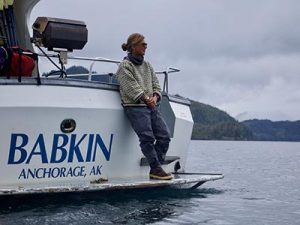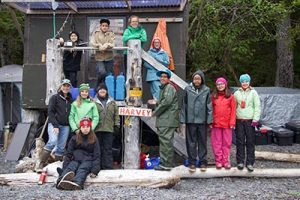By Lisa Matlock
Outreach Coordinator
As the skiff sailed across Cabin Bay, high-pitched twittering and piping sounds echoed over the water. Four football-shaped black birds with white wing patches on the water near the point seemed engrossed in calls emanating from speakers and several decoys sitting rigidly on the rock. One of the teens pointed and yelled, “There they are!”
Sam Stark, an Oregon State University researcher leading the teens on their bird adventure, smiled and congratulated her on her keen eye. Stark developed several activities for these lucky middle schoolers, to teach them how scientists work to restore populations of wildlife affected by a major oil spill.
At the end of that day, one of the teens exclaimed that they never knew science could be so interesting.
 Expedition is one of many
Expedition is one of many
Since 2009, the Council has helped support projects that involve youth in our mission and understanding of our work. This support has grown from a couple of projects in the first year to include ten partner projects from Kodiak to Cordova last year.
One of the projects that the Council has helped support since 2010, is Alaska Geographic’s Prince William Sound Youth Marine Stewardship Expedition. This expedition introduces middle schoolers to Prince William Sound to explore and learn. Youth from Cordova, Valdez, Whittier, Homer, Kodiak, Soldotna, Girdwood, Seward, Cooper Landing, Anchorage, Fairbanks, and Palmer have traveled aboard the Babkin each summer for a week, exposed to science of all kinds happening in the Sound. Youth involved in the expedition are nominated by teachers who think they would most benefit from the experience.

Part of the curriculum includes the science and history of the Exxon Valdez oil spill. The students experience effects of lingering oil in the Sound along with an introduction to current oil spill prevention and response efforts in place to protect its marine environment today.
Council volunteer Kate Alexander Morse has been the science instructor on previous expeditions.
“This expedition provides big opportunities for personal growth in kids who may not have been on an adventure of this kind,“ Morse says. “It pushes their boundaries and provides a chance for them to explore who they are at a fragile time in life. And it provides learning outside the classroom. I feel that an important part of being a Council volunteer is to help foster the importance of stewardship for Prince William Sound in these kids, for the long term health of the Sound.”
Becoming stewards of the environment
 “Several of our most long-term youth involved in programs became hooked on this kind of learning through their Babkin trip,” says Ann Mayo-Kiely of Alaska Geographic.
“Several of our most long-term youth involved in programs became hooked on this kind of learning through their Babkin trip,” says Ann Mayo-Kiely of Alaska Geographic.
After these kids return to their regular lives, many take advantage of continued opportunities for outdoor adventure, leadership skills building, and science education. One former expeditioner presented at the Council’s 2010 Science Night and another from Cordova became an invasive species intern for the Council.
Besides the Council, partner support for the expedition this year included: Alaska Geographic, Chugach Children’s Forest, Prince William Sound Aquaculture Corp., Alaska Department of Fish and Game, Oregon State University (with support from the U.S. Fish and Wildlife Service and the U.S. Geological Survey), Copper River Watershed Project, and Susan Harvey.
I was lucky enough to serve as the science instructor for this year’s expedition, and it was gratifying to see what the kids learn and how they grow in the Sound. This Council project benefits our youth for life, and our mission.